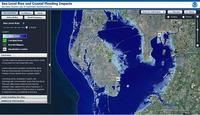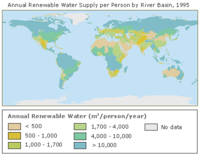-
Melting Arctic sea ice increases summer rainfall in northwest Europe
A new study offers an explanation for the extraordinary run of wet summers experienced by Britain and northwest Europe between 2007 and 2012. The study found that loss of Arctic sea ice shifts the jet stream further south than normal resulting in increased rain during the summer in northwest Europe. The annual average extent of Arctic sea ice is currently declining at about half a million square kilometers per decade — equivalent to about twice the area of the United Kingdom.
-
-
Peru reopens UFO investigation office
The Peruvian air force, saying it was responding to an “increased sightings of anomalous aerial phenomena” in the country’s skies,” has reopened its Departamento de Investigación de Fenómenos Aéreos Anómalos (DIFAA). The investigative office was established in 2001 but closed in 2008. DIFAA will bring together sociologists, archaeologists, astronomers, meteorologists, and air force personnel to analyze these anomalous events. Peru is not the only Latin American country showing renewed interest in UFOs.
-
-
New method to help coastal communities adapt to sea-level rise

Future sea-level rise seems inevitable, although the rates and geographical patterns of change remain uncertain. Given the large and growing populations and economic activity in coastal zones, as well as the importance of coastal ecosystems, the potential impacts of sea-level change are far-reaching. Current methods to assess the potential impact of sea-level rise have varied significantly and hindered the development of useful scenarios and, in turn, suitable adaption policies and planning.
-
-
Burping for power: Tapping cow burps for natural gas
Scientists in Argentina have developed a method to transform the gas created by cows’ digestive systems into fuel. The technique channels the digestive gases from bovine stomach cavities through a tube and into a tank, where the gases, called eruptos (burps) in Spanish, are processed to separate methane from other gases such as carbon dioxide.
-
-
$32 million NSF grants for improving prediction of, response to natural disasters
With Sandy’s one-year anniversary – 29 October – next week, how do scientists better predict and respond to natural hazards such as hurricanes, tornadoes, floods, earthquakes, tsunamis, and wildfires? To find answers, the National Science Foundation (NSF) recently awarded twelve new research grants totaling $32 million. The awards will advance understanding of natural hazards and of technological hazards linked with natural phenomena, as scientists study ways of predicting and responding to hurricanes, tornadoes, floods, earthquakes, tsunamis, wildfires.
-
-
More than 500 million people could face increasing water scarcity

Both freshwater availability for many millions of people and the stability of ecosystems such as the Siberian tundra or Indian grasslands are put at risk by climate change. Even if global warming is limited to 2 degrees above pre-industrial levels, 500 million people could be subject to increased water scarcity.
-
-
The only effective asteroid defense: early detection – and evacuation of impact area

For the threat of meteor strikes large or small, early detection is key, and evacuation may be the only defense needed within the next 1,000 years, according to an asteroid impact expert. He says that the best investment in asteroid defense is not in weapons to deflect them, but in telescopes and surveys to find them.
-
-
Weatherizing U.S. homes to uniform standard to save $33 billion a year
The U.S. residential sector — 113 million homes — uses about 23 percent of total U.S. source energy annually (source energy includes site energy, the energy consumed by buildings for heating and electricity, as well as the raw energy required to transmit, deliver and produce it). A new study finds that upgrading buildings’ airtightness to a uniform level could achieve as much as $33 billion in annual energy savings.
-
-
Better protective shield material for nuclear waste
The integrity and survivability of a nuclear waste package is critically important in the transport of nuclear fuel and high-level waste. Research are working on developing an outer shield material for use in packaging which is resistant to corrosion, radiation, diffusion, and thermal cycling processes that affect fuel packages during long-term storage. The material will also need to be wear-tolerant and mechanically robust so that it can survive repeated handling and transportation.
-
-
Geologists: Sandy could happen again
Sandy’s storm surge hit the coast at high tide, but storm and tidal conditions were not the only cause of the devastation. Seawaters off New York’s coast have risen sixteen inches since 1778, the year of New York City’s first major recorded storm. Geologists say that due to rising sea levels, smaller storms could produce significant flooding.
-
-
Using hills to shelter buildings from tornadoes
Researchers have demonstrated the influence of hills on tornadoes. The researchers’ models revealed that the height of a hill and the size of a tornado’s vortex have a significant effect on the tornado’s destructive power. The findings could be used to identify safer areas for construction.
-
-
U.S. formulates strategy for a new Arctic landscape
U.S. national security officials have become increasingly concerned about the national security implications of an ice-free Arctic. The Arctic will become ice-free during the summer by mid-decade. In a strategy document, the Pentagon says: “Melting sea ice in the Arctic may lead to new opportunities for shipping, tourism, and resource exploration, but the increase in human activity may require a significant increase in operational capabilities in the region in order to safeguard lawful trade and travel and to prevent exploitation of new routes for smuggling and trafficking.”
-
-
Coast Guard to discuss new U.S. Arctic strategy
The future of the Arctic has become a hot topic in U.S. national security, energy, and policy circles. The Washington Homeland Security Roundtable (WHSR) has organized a forum for private-sector leaders in which Vice Admiral Peter Neffenger, deputy commandant for operations of the U.S. Coast Guard (USCG), and Captain Jon Spaner, USCG director of emerging policy, will discuss the ramifications of climate-driven changes in the Arctic for U.S. national security and maritime operations, and share insights on the role of the USCG in meeting the challenges posed by a new ocean created by rapidly melting ice.
-
-
Maryland preparing for sea level rise
Maryland has 3,100 miles of tidal shoreline. A scientific report recommends that it would prudent for the state to prepare for a sea level rise of 1.4 feet by 2050.Maryland’s CoastSmart Communities Initiative (CCI) provides grant funding for coastal communities which want to reduce their vulnerabilities to the effects of coastal hazards and sea level rise by becoming ready, adaptive, and resilient.
-
-
Maryland preparing for sea level rise
Maryland has 3,100 miles of tidal shoreline. A scientific report recommends that it would prudent for the state to prepare for a sea level rise of 1.4 feet by 2050.Maryland’s CoastSmart Communities Initiative (CCI) provides grant funding for coastal communities which want to reduce their vulnerabilities to the effects of coastal hazards and sea level rise by becoming ready, adaptive, and resilient.
-
- All
- Regional
- Water
- Biometrics
- Borders/Immig
- Business
- Cybersecurity
- Detection
- Disasters
- Government
- Infrastructure
- International
- Public health
- Public Safety
- Communication interoperabillity
- Emergency services
- Emergency medical services
- Fire
- First response
- IEDs
- Law Enforcement
- Law Enforcement Technology
- Military technology
- Nonlethal weapons
- Nuclear weapons
- Personal protection equipment
- Police
- Notification /alert systems
- Situational awareness
- Weapons systems
- Sci-Tech
- Sector Reports
- Surveillance
- Transportation
Advertising & Marketing: advertise@newswirepubs.com
Editorial: editor@newswirepubs.com
General: info@newswirepubs.com
2010-2011 © News Wire Publications, LLC News Wire Publications, LLC
220 Old Country Road | Suite 200 | Mineola | New York | 11501
Permissions and Policies
Editorial: editor@newswirepubs.com
General: info@newswirepubs.com
2010-2011 © News Wire Publications, LLC News Wire Publications, LLC
220 Old Country Road | Suite 200 | Mineola | New York | 11501
Permissions and Policies
